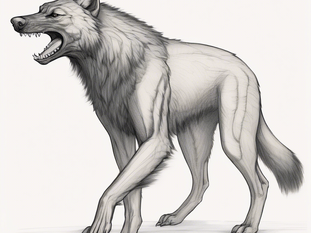The legend of the Chupacabra fascinates many, straddling the boundary between myth and reality. Materialized from Latin American folklore, the Chupacabra, meaning "goat-sucker," has gripped numerous individuals with fear, transfixed by its ominous reputation. Frequently seen as a predator of livestock, particularly goats, this legend has endured over the years. Why has it persisted? What can we learn about its beginnings and different versions? Join us as we dive deeper into the Chupacabra phenomenon, exploring the tales, sightings, and interpretations linked to this enigmatic, vampiric, mangey dog like creature.
The Origins of the Chupacabra Legend
The first documented sighting of the Chupacabra took place in Puerto Rico in the mid-1990s. Reports surfaced that livestock were dying under mysterious circumstances. Farmers shared chilling stories of a creature that drained the blood of goats, leaving behind carcasses with distinct, puncture wounds. By 1995, about 150 livestock deaths were reported in Puerto Rico alone, sparking widespread fear and speculation. Communities were left grappling with what they believed might be a new predator in their midst.
This legend quickly spread beyond Puerto Rico, with sightings popping up across the Americas, and even into parts of Europe. Different reports characterized the creature; some depicted it as a reptilian dog, while others described a small, hairless monster. The range of depictions only fueled curiosity and concern.
Variations in Descriptions
Descriptions of the Chupacabra have varied widely, often reflecting local culture and lore. In some regions, it is imagined with green, scaly skin and large red eyes. In stark contrast, others describe it as resembling a mangy dog.
For instance, in 2003, residents of San Antonio, Texas reported sightings of what they believed to be a Chupacabra, describing it as a creature about the size of a small bear. The media sensationalized these stories, leading many to wonder: could these sightings be attributed to sick local wildlife? The image of hairless canines suffering from mange may have contributed significantly to the Chupacabra narrative.
Notable Sightings and Investigations
As the Chupacabra legend evolved, numerous sightings captured public attention. A remarkable case occurred in 2004, when a Texas rancher claimed to have witnessed a Chupacabra attacking his goats. He described it as being approximately three feet tall with a pronounced spine, and its unusual behavior raised eyebrows.
Further investigation revealed a pattern: many sightings reported that the creature stalked its prey stealthily before striking. Wildlife experts have often examined these claims, and some attributed the sightings to known predators like coyotes or feral dogs. For example, a study from 2006 indicated that many alleged Chupacabras were likely malnourished canines suffering from rabies or other diseases.

Scientific Explanations
While many are drawn to the Chupacabra legend as a captivating mystery, scientists have sought logical explanations. Research into reported sightings frequently leads to the discovery of diseases affecting local wildlife, revealing how easy it is to misinterpret what one sees.
Many scientists assert that misidentifications occur regularly among wildlife, particularly when animals are suffering from conditions like mange or starvation. The notion of cryptids—undiscovered creatures—delights both enthusiasts and skeptics.
Final Thoughts on the Chupacabra Myth
The Chupacabra for us Vaulters continues to be a compelling legend that inspires both curiosity and warrants further investigation.
At Urban Legend Vault, we know your story matters, Vaulters! Every experience you share is a piece of our cultural history, a thread that strengthens our community of passionate individuals, and a spark that inspires others to share their own encounters.
Share your stories in the Vaulters form , or leave a comment below!
Until next time, keep your eyes peeled and your mind open. New blog updates are posted weekly, so be sure to check back and follow us on social media for the latest update



